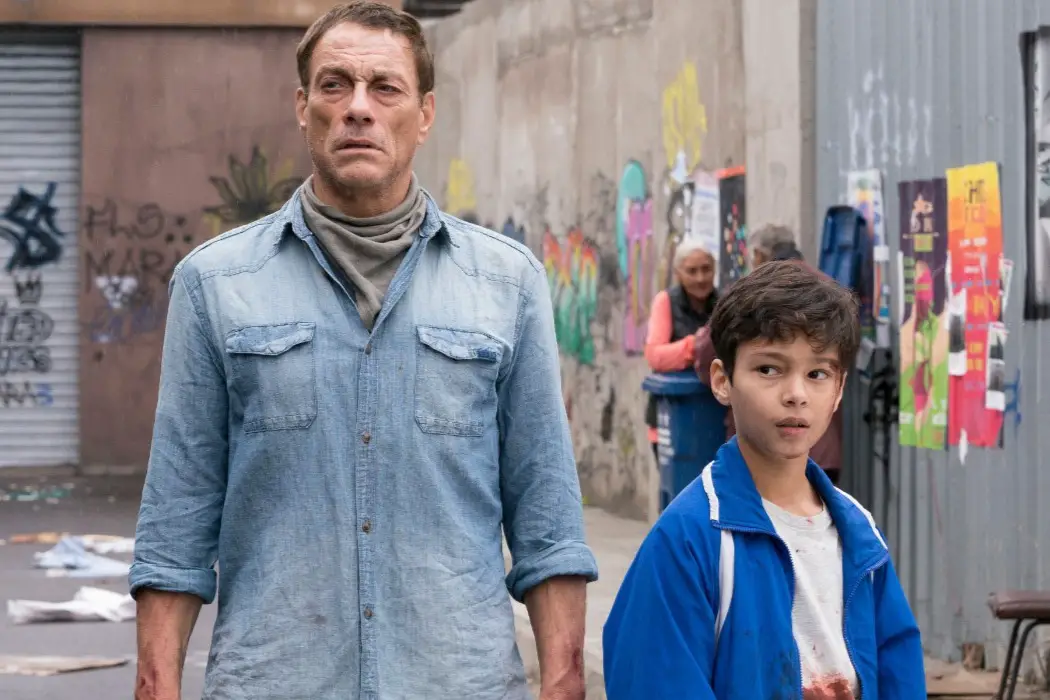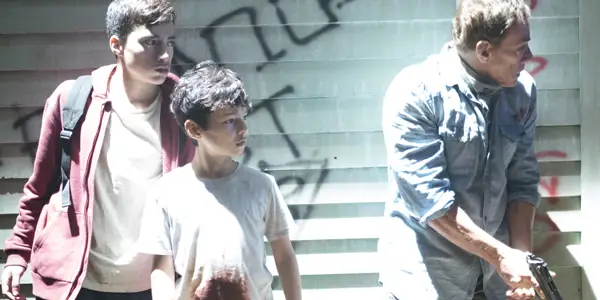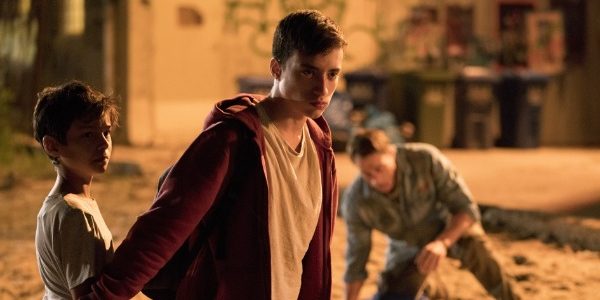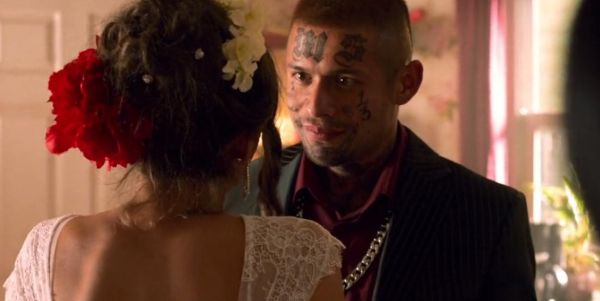WE DIE YOUNG: JCVD Nostalgia Buoys A Glib Gangster Picture

John Stanford Owen received his MFA from Southern Illinois University,…
He once played a police officer who travels through the portals of time.
He once played a martial arts tournament champion who smashes bricks into powder.
He once played a fallen Vietnam War veteran whom the government reanimates as a cyborg killing machine.
In the 80’s and 90’s, Jean-Claude Van Damme roundhouse-kicked his way through blockbuster roles forged from a 12-year-old’s most fantastic of daydreams. But We Die Young, the action movie icon’s latest effort, breaks that oh-so-familiar template: no cheeky one-liners, no fight scene acrobatics, no rescue sequence unfolding in slow motion near the end of the third act. In fact, director Lior Geller erases the customary, semi-contractual tropes that gave most viewers reason to watch his films in the first place.
Let’s not kid ourselves. Many will nestle in front of their televisions with hopes of seeing the 58-year-old JCVD continue to rock the martial arts mojo required to break bones with a single blow. But, if that’s the case, they’ll experience vast disappointment. Instead, this story sees him play a dejected war veteran suffering from PTSD and bodily injuries so severe that his character remains wholly unable to speak. As a result, the director enters a danger zone that leaves him vulnerable to claims of bait and switch. While We Die Young includes a hefty amount of bombastic gunfire, mano-a-mano knife fights, and spurting blood, Geller aims for dramatic prestige over cheap thrills.
Violating the Imaginary Covenant
JCVD’s name and image feature prominently on the film’s cover art, but he spends far less time on screen than his young co-star, Elijah Rodriguez who plays the adolescent drug runner Lucas. As the creators attempt to break away from snackable action films, it seems unfair to keep Geller and JCVD trapped inside a genre bubble. Yet, for many of us who came of age amid the decade-long pinnacle of Van Damme’s superstardom, his oeuvre leaves us burdened with a persistent nostalgia, an invisible contract that so often creates a tumultuous relationship between autonomous filmmakers and audiences harboring inflexible expectations.

After all, we’ve watched him trade furious karate chops with Bolo Yeung, the pectoral-flexing baddy who made a name for himself in a silver screen battle with Bruce Lee. And we’ve witnessed JCVD escape the clutches of a penguin mascot (yes, while wearing the full costume) who seeks to peel our hero’s face off via deli meat slicer. To wit, the bulk of his movies include him performing the splits with the effortlessness it takes lesser mortals to turn oxygen into carbon dioxide. Really, as long as you strip the self-awareness away, a Van Damme film from his golden era mirrors the Theatre of the Absurd in its purest incarnation. But, if you’re looking to tap into the specific euphoria spectacularly overwrought action films once produced for you, I suggest popping in the trusty, old Bloodsport DVD instead of watching We Die Young.
In 2019, you’ll be viewing a new breed of JCVD motion picture, one with a notable absence of aerial kicks and exploding boats. In fact, while playing Daniel, the action star never utters a word, much less any well-timed braggadocio that helped make him and contemporaries such as Arnold Schwarzenegger famous. A veteran of America’s endless wars in the Middle East, Daniel lost not only his speech, but also his chance at happiness. By any measure, the character works as a poster child for the tyranny of the industrialized war machine, and thus, while hobbling around the ramshackle streets he calls home, he swallows fistfuls of Oxycontin to cope with the agony. Left ambiguous, the source of that strife stems from physical wounds, psychological trauma, or a combination of both.
Welcome to Hurricane Pathos
The film’s quality flatlines in most respects, but nevertheless, the multidimensional character development and the attempt at dramatic nuance deserves a critical nod. Few contemporary directors—Guillermo del Toro providing one exception—manage to successfully dedicate an entire three-act movie to a character unable to deliver spoken dialogue. And the filmmakers don’t attempt to put JCVD’s character in the spotlight. After all, the VFW doesn’t supply those painkillers to Daniel; it’s 14-year-old Lucas who sells him the pills. And it’s Lucas who receives the primary focus. A reluctant but resigned gang member, Lucas runs heroin bricks to various drop-off points, collecting payments and returning to his boss’ headquarters for the next delivery assignment. He does this with the hope that his younger brother stays free from the MS13 gang’s stranglehold. Even though this description is sensational in itself, it covers only the smallest sliver of the glib pathos yet to occur.
With their faces smothered in a mask of tattoos, the gang governs the impoverished streets bordering Washington D.C. Meanwhile, we witness the military recruiting children for the next generation of international conflict with promises to lift them out of economic devastation. Later, as ethereal voices pipe through the film’s otherwise drumbeat-heavy score, we watch a child writhe in the fetal position as he takes a barrage of ferocious kicks. Of course, it’s the little brother character on the receiving end of the gang’s jump-in initiation.

Despite its lukewarm flirtation with Oscar season character arcs, We Die Young remains steadfast in the action flick category. Nevertheless, it bares repeating that the script’s ambition dives deeper than the theatricality of choreographed violence. Bullets whiz past and shred bodies in their wake, but Geller attempts to splice in sociopolitical exploration amid all the blood-and-guts hullabaloo. The narrative crux follows the brothers as they make a literal, time-sensitive escape.
In other words, more favorable circumstances exist elsewhere, but first, the boys must reach the destination. With JCVD escorting them through the impromptu battlefields created by gangs and police spraying bullets at one another, Lucas rushes his brother toward the train that will take them both away from a life where horrific violence is all too commonplace. It is as though all those beatings and shootings serve as the wallpaper of their lives. All they need to do is move to a new house.
The attempt to balance gangster film motifs with sociopolitical awareness merits appreciation, yes, but the effort falls flat as the narrative unfolds into a litany of unrelenting pathos that relegates the script to a cheapness mirroring an after-school special.
We Die Young: The Exploitation of Tragedy
When many filmmakers create sprawling narratives that neglect to factor in the endurance of the human bladder, We Die Young clocks in at a pithy hour and a half, though not enough story exists to necessitate even the slimmest run time. To populate the 90 minutes, Geller includes long cross-cutting sequences that show simultaneous violent acts. But even outside of that filler material, the director relies on a script rife with over-the-top sensationalism. Is it all so heavy-handed? No. Though gratuitous, a knife fight sequence shows how the director has a knack for precision. That scene splices a string-centric score with metallic slicing sounds, an artistic choice that proves the studio let a little authorship slip past their control.

The cinematography amounts to a shaky cam technique that looks like a found footage film during the part when whatever supernatural entity appears for the first time. The form and content combination happens as no accident. It shows hints that Geller might one day find himself in the auteur category. His directorial signature becomes apparent as the screen fades in and out of black like a shorted-out fluorescent light, revealing snapshots of human devastation in between.
We Die Young is not an arthouse masterpiece, nor does it want to be. It aims to add social context to an otherwise hackneyed gangster film. The attempt is sincere, but given its reliance on random snapshots of extravagant suffering, that objective also goes belly up. Ultimately, though Geller shows serious directorial chops in a few moments, the movie amounts to an exercise in tragedy porn.
The title itself foreshadows the avalanche of pathos about to start tumbling down. Walking past a murdered body in this world is as common an occurrence as seeing a UPS truck. Especially when it comes to the reality of war, poverty, and addiction, visceral candor provides filmmakers with a powerful and necessary weapon, but as bodies fall like so many dominoes, the story becomes a series of emotional sucker punches.
Do actors hold a contract with their audiences? What are the rules with creation versus expectation?
We Die Young Was released in the USA on March 1.
Does content like this matter to you?
Become a Member and support film journalism. Unlock access to all of Film Inquiry`s great articles. Join a community of like-minded readers who are passionate about cinema - get access to our private members Network, give back to independent filmmakers, and more.
John Stanford Owen received his MFA from Southern Illinois University, where he also taught English courses. When JSO is not penning reviews and essays on cinema, he's reading and writing poetry, walking with his dog, or dancing to Radiohead.













